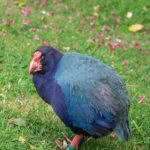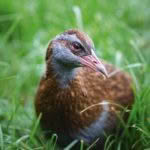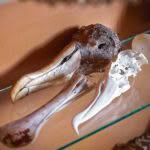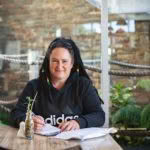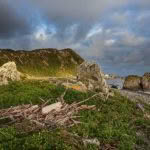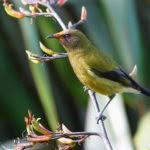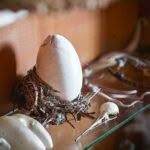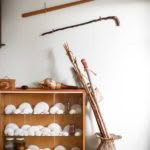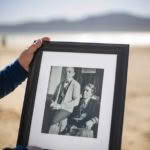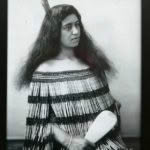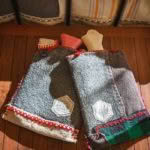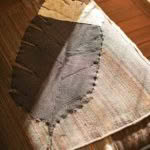Meet the Barrett whanau the guardians of bird-lover’s paradise Kapiti island and Kapiti Island Nature Tours lodge
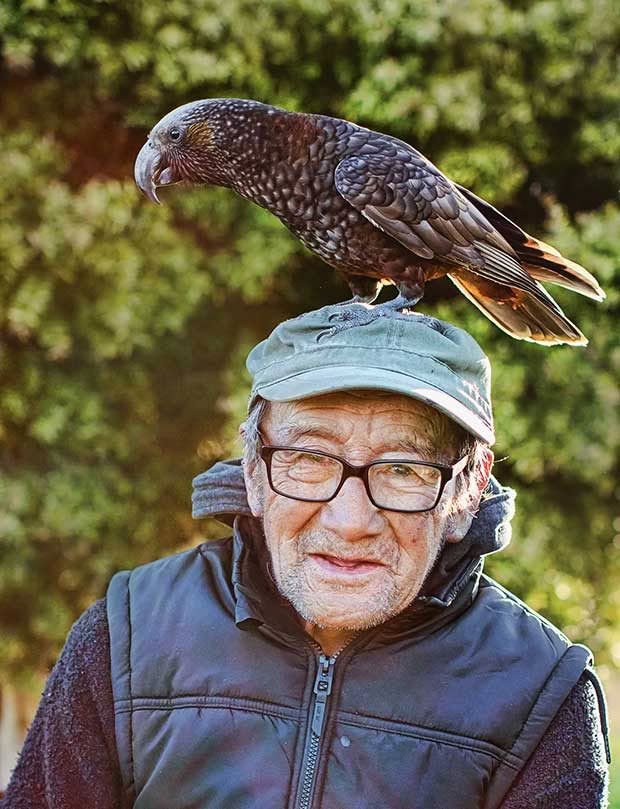
Boysie Barrett is a favourite of the kākā. “I know the names of every one of them,” he says. “They all have different characteristics. This kākā is called Charlie Bird.”
The vast majority of Kāpiti Island is a nature reserve. But 20 hectares of the iconic island is privately owned by a whānau dedicated to preserving their whakapapa — including the land and everything upon it — and sharing it with the world.
Words: Lee-Anne Duncan Photos: Tessa Chrisp
On Kāpiti Island the birds most definitely call the tune. Along with their never-ending song, they’re a constant physical, feathery presence. Loud rustling in the bush beside walking tracks could be concerning had not all mammals — bar humans — been eradicated since 1996. Despite that, Manaaki Barrett has a few warnings as he welcomes visitors to his family’s Kāpiti Island Nature Tours lodge.
“Watch out for the kākā. On other parts of the island they get into your bags looking for food, but here they have a different strategy — they hang around the lodge doors waiting for people to take food outside. If you do, don’t leave it unattended and be prepared for them to come and land on you.”
Light-beaked weka, too, present a challenge. “They’ll steal anything left on the ground and will try come inside. So keep doors closed,” says Manaaki.
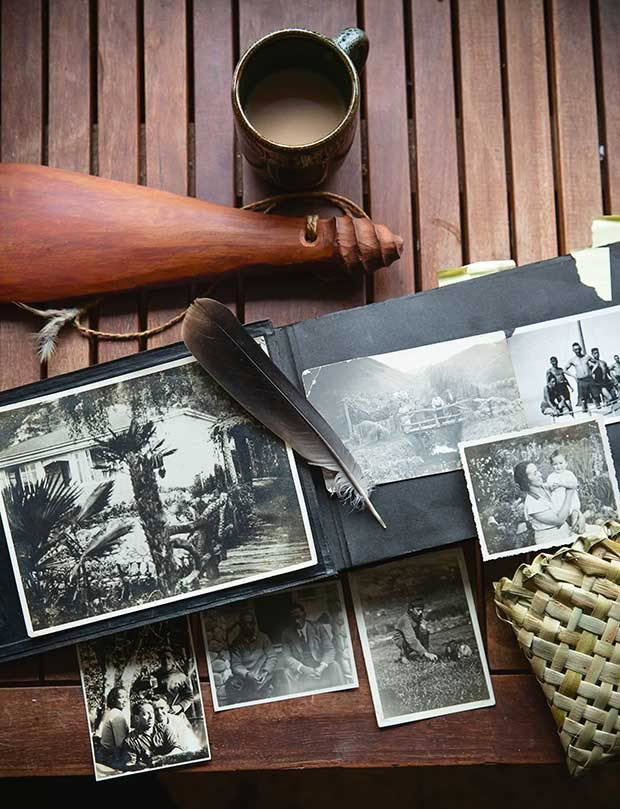
The Barrett whānau have been on Kāpiti Island since their ancestor arrived with Te Rauparaha in the 1820s. Two centuries later, the family is still going strong, caring for its land. The Kāpiti Island Nature Tours lodge showcases the whānau’s island history to the nearly 2000 visitors — Kiwi and international — who stay here each year.
It also pays to watch for resting kererū, especially when walking down the tree-lined paths to the lodge’s cabins. “You don’t want to be under a kererū ‘bomb’,” says Manaaki. Naturally, it’s all said with great affection. Everyone on Kāpiti Island knows this place is all about the birds and is willing to adapt. The island is a vivid and vocal example of what investing in eradicating pests can achieve. The list of resident native birds is extensive, the dawn chorus is raucous and roly-poly kererū are confident enough to feed on the ground — something unseen on the mainland.
Manaaki is the 32-year-old son of John Barrett. John and his wife Sue and sister Amo Clark have built up Kāpiti Island Nature Tours over the past two decades on land towards the north end of the island. The whānau have lived there in some shape for the past 200 years since their ancestor Te Rangihiroa journeyed from Waikato with the famed and feared warrior Te Rauparaha and settled on Te Waewae Kāpiti o Tara rāua ko Rangitane (mercifully shortened to Kāpiti Island).
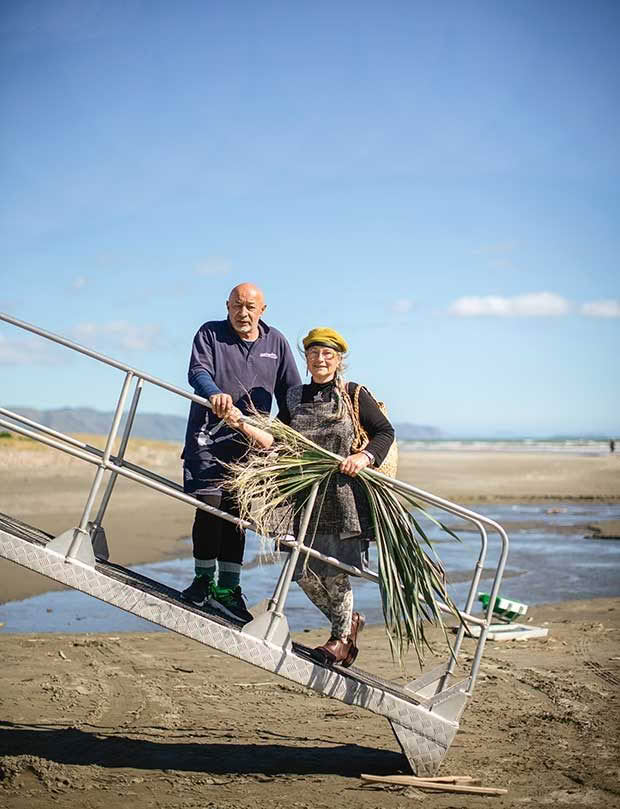
John and Sue Barrett set up Kāpiti Island Nature Tours with John’s sister, Amo Clark, 20 years ago. Everything and everyone must travel to the island by launch from Paraparaumu Beach. Sue weaves all the flax placemats and decorations at the lodge.
These days, John’s brother Boysie is the only full-time inhabitant (“it’ll take a bulldozer to get me off the island”), with the other whānau splitting their time between the mainland and the island. But their collective dedication to their whenua is rock solid.
“When we set up Kāpiti Island Nature Tours, the whole kaupapa was to provide an opportunity for the whānau to do something positive and productive for ourselves,” says John. “What’s happened over the past 20 years is that we’ve become stronger with our whakapapa, and stronger in providing a Māori/conservation/soft-adventure tourism product. We want to be developing something that’s great, not just good — something that people talk about and that enhances the mana of our whānau, hapū, iwi and district. We have plans for improvement, but we seem to be doing that.”
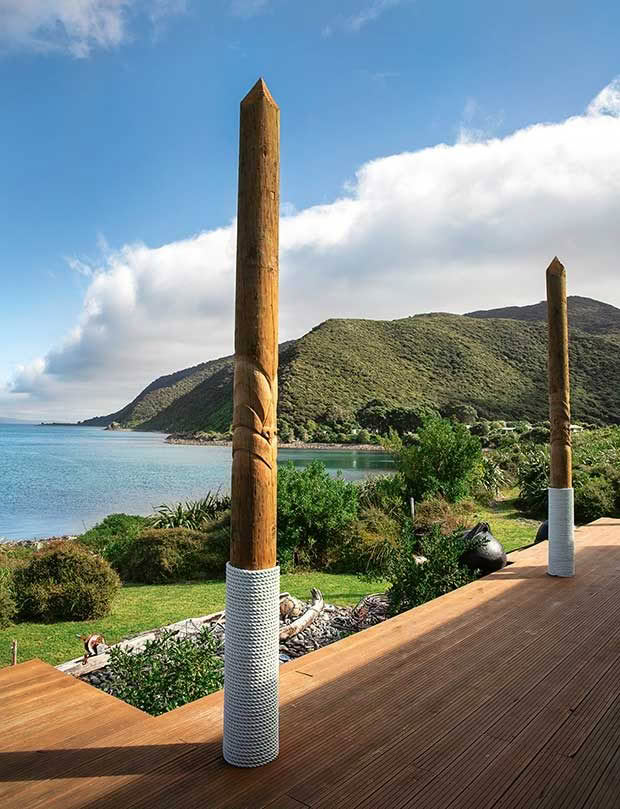
And the numbers show that’s so. Over the past five years, the number of visitors Kāpiti Island Nature Tours has brought to the island has increased markedly. In the 2013/14 operating year (generally September to May, weather dependent), the business led 2626 to the island, 1000 of whom spent a night in the lodge, which sleeps up to 20 and is the only way to stay the night. In the 2017/18 year, 6029 visited and 1964 slept over. The Department of Conservation allows up to 160 visitors to the island each day, a maximum that’s often met.
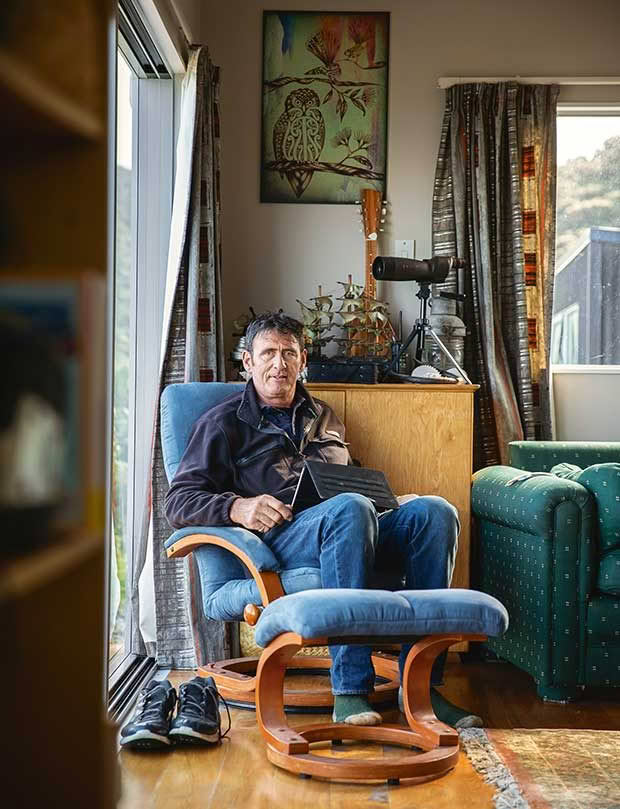
Wayne Spratt, John’s cousin, has a prime spot on Kāpiti Island looking towards the lodge across Waiorua Bay.
Kāpiti Island fair looms over the coast that shares its name. So perhaps it’s surprising how many locals have never made the trip. But Ōtaki born-and-bred Sue Barrett (John’s wife and Manaaki’s mother) understands. “Kāpiti Island is very spiritual for a lot of people in the area and some, I think, feel if they came it might spoil the feeling they have of it.”
In fact, despite his family’s then-150-year connection to the island, as a younger man John didn’t feel particularly connected himself. He grew up in Ōtaki with his three siblings — all of whom now have houses on the island — and came over during his primary school holidays “mostly because it was something fun to do”.
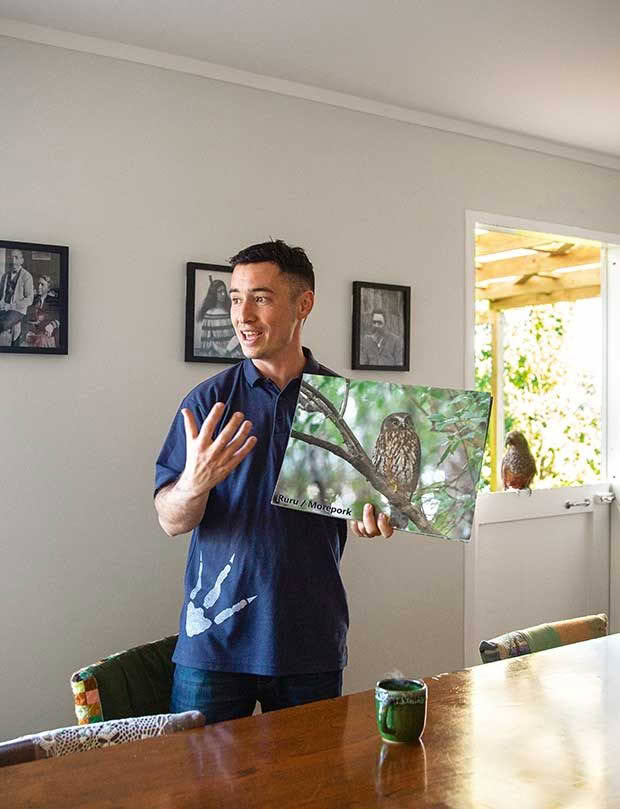
Manaaki Barrett’s welcome talk includes an introduction to the birdlife — with some appearing in person. Manaaki now handles most of the lodge’s management having left his Wellington bank job seven years ago. He loves the connection to his history the move allows him. “If I’d stayed in the city, working in an office, the path I took to reconnect with my whakapapa and culture would have been slower. Being here in the same place as my great-great-great-great grandfather is a powerful way of connecting with that.”
Sue also has a whānau connection as her grandparents farmed at Rangitira, at the mid-point of the island, back before the government bought the island — bar the Barretts’ bit — and decreed it a nature reserve in 1892.
As the bush regenerated around them, John’s whānau continued to farm their piece of the island until 1966, the generations doggedly resisting government pressure to hand over their land. After John’s uncle left the farm in 1966, no one regularly came to the island until John and Sue started building their bach in 1975. At that point they both lived and worked in Wellington — John as a travel agent for Thomas Cook, Sue for the Meat and Wool Board (she’s now a kindy teacher).
- Bellamy the takahē is blind but — with no predators — continues to live life happily.
- Wēkā wait to thieve what they can.
- Whether alive or no longer.
- Minnie Clark runs the visitor bookings and launch transfers.
- The north end of Kāpiti Island is a nesting area for royal spoonbill.
Back then, the bach was basic. “The first night we stayed over it swayed a lot. There was a lot of re-bracing in the morning,” says Sue. Even getting to the island in the family’s 15-foot Plylite boat was an adventure and the journey across forms one of Manaaki’s first memories. “I remember the island being more wild and inaccessible, and the mission to get here made it a different adventure to what it is today. It’s all a bit more luxurious to what it was back then,” he says.
Today’s lodge has grown up around the original bach and strikes the right balance between creature comforts and family holiday home. There are clean cabins and glamping tents, three meals are offered as part of the package for overnight guests, and day-trippers can also eat lunch at the lodge. It’s not five-star luxury, but people don’t come to Kāpiti for that.“People love the whānau-bach feel of the place,” says John.
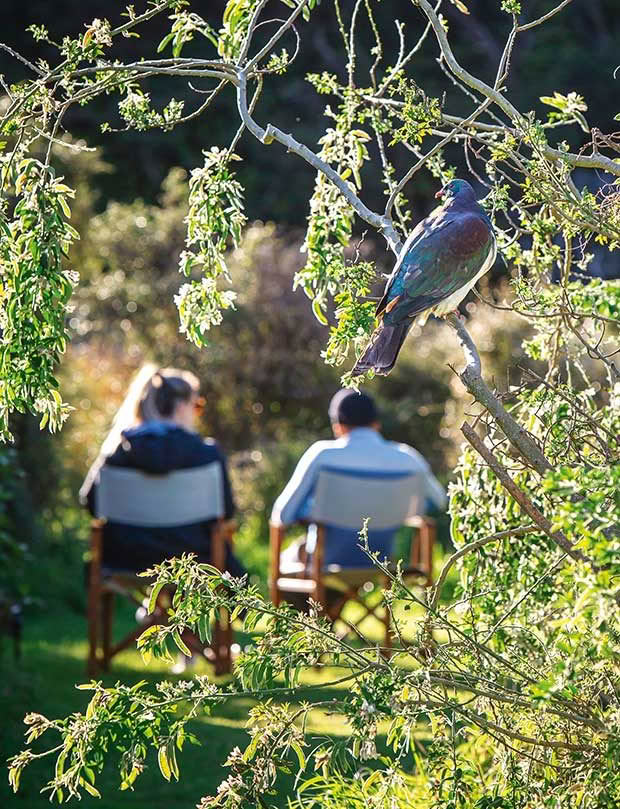
Kererū feeding on the ground are a common sight around the lodge, but they also rest in trees and their “bombs” can pose a “danger” for visitors passing underneath.
“We can’t improve on the natural aspects of the island. The bush regeneration is taking place at a fantastic rate. Since we’ve been here, we’ve seen the bush grow down the valley towards us, we hear kōkako up the valley, and we have saddlebacks here and takahē wandering around the lodge. “It just feels good to be here. It feels like the right place to be. And as I’ve become older, the rationale becomes clearer; that it’s to do with wider whānau connections, it’s about our great-grandparents and the whole whakapapa.”
This reasoning kept John fighting when the former Department of Lands and Survey tried hard to split the whānau and claim the land for the reserve. He was the latest whānau member to face such pressure — successive grandmothers refused to engage with the government through the late 19th and early 20th centuries. To ensure future unity, in the 1980s John and his siblings vested the land into a family trust with each beneficiary — the children of Pikitia Webber, who grew up on the island and at Parihaka — leasing their portion from the trust and building their own baches.
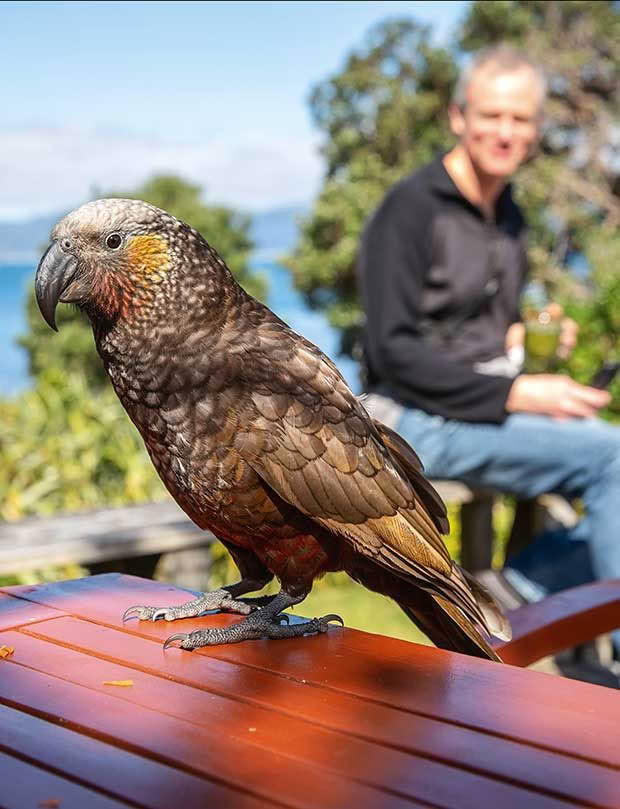
Visitors are also warned to watch for kākā, who use any strategy they can to help themselves to food.
When the Department of Lands and Survey became the Department of Conservation, the relationship became easier.
“DOC has an obligation to the Treaty of Waitangi in its legislation. It’s happy to exercise that obligation and allow us to keep our part of the island,” says John. He says the whānau enjoys a “respectful and collaborative” relationship with the department and its various staff who visit around the lodge, tracking the area’s fauna and flora. With their portion of the land, back in the 1980s, John and Sue ran a 10-week residential programme for 17- to 25-year-olds. “It was a mix of recreation, education and conservation,” says John. “Then we had parents asking if they could come and stay, then friends of parents, then friends of friends.” When the programme’s funding stopped in the mid-1990s, Kāpiti Island Nature Tours began.
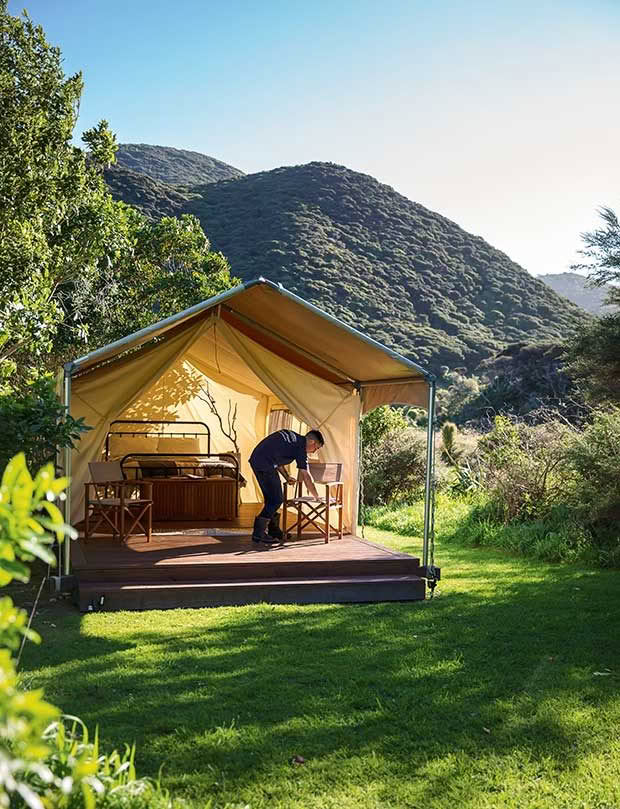
Visitors to Kāpiti Island Nature Tours lodge can sleep in cabins or one of two glamping tents, for an up-close night-time bird experience.
While John’s still very much involved in the venture, Manaaki has taken over a lot of the business operation. He’s been involved now for seven years or so after “pottering away at city life” and working in a bank until his mid-20s. “It’s become more and more obvious that coming here was a good move. I didn’t come over with a full understanding of the value to us in terms of the opportunity we have to share our story in a way that doesn’t negatively impact on us as a whānau, but rather enhances our understanding of who we are and where we are,” he says.
“The longer I stay here, and the more I see how other indigenous people around the world lack an opportunity to connect to their place and to share it, I see that what we have is pretty special. We’re here talking about our history every day so our connection with our culture and our whakapapa is enhanced and cemented,” says Manaaki.
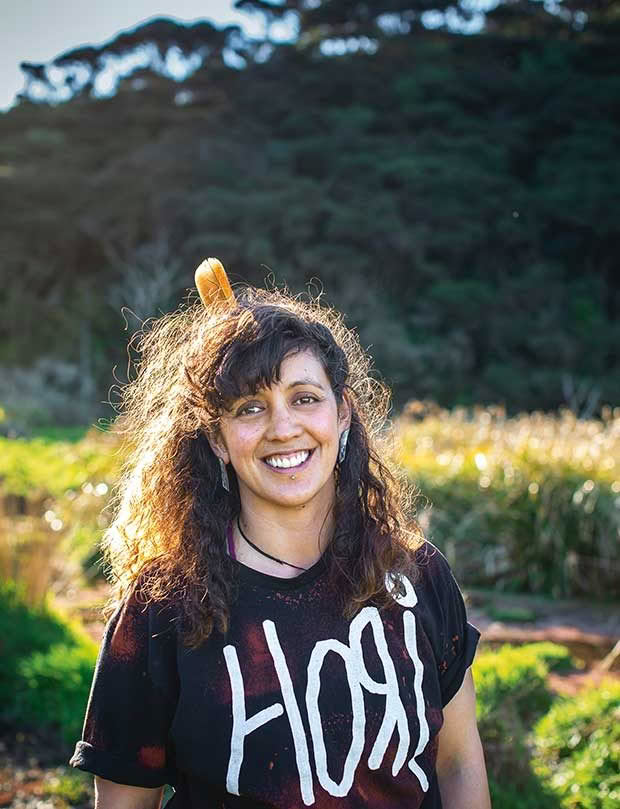
Pania Barrett takes on visitor-welcoming duties when Manaaki is on the mainland.
While some visitors come to tick off a list of birds, Manaaki says most are interested in Kāpiti Island’s human story and the majority, 75.3 per cent to be precise, are New Zealanders. “People genuinely get a lot out of their experience here. So it’s quite a nourishing thing for us to put our efforts into facilitating that experience, helping our manuhiri get the best out of Kāpiti.”Sue jokes that when the lodge opened to visitors, the then-12-year-old Manaaki wasn’t so keen to share. But that’s all changed. “What has been built today can sustain our family in lots of ways. If, as a family, we can build a business around our presence here that will sustain our land, our whakapapa, and connect us with our tūrangawaewae while sharing that with visitors then I’m in.”
KĀPITI ISLAND’S HUMANS
Kāpiti Island’s human story goes back hundreds of years, but the Barretts’ began in the 1820s. “There were two main waves of migration around then, by sea and hīkoi, when tribes from Ngāti Toa, Te Ātiawa and Ngāti Raukawa came from Waikato and Taranaki,” says John Barrett, a direct descendent of that migration.
- The tūpuna — Hona and Utauta Webber.
- MP Wi Parata.
- Utauta as a young woman.
They were led by Te Rauparaha, the Ngāti Toa chief who swept down the west coast of Aotearoa after being forced out of Waikato. But the Barretts trace their whakapapa to another warrior who traveled with him, Te Rangihīroa. Over the next 20 years, the area was settled by whalers and sealers, followed by traders and farmers. Then, in 1840, the Taranaki tribes left Kāpiti to return to fight in the land wars going on in their home region. “We have this land because Te Rangihīroa’s mother, Metapere Waipunahau — my granny’s grandma — and a few other families were left behind to look after it,” says John.
Metapere Waipunahau had two sons, Hemi Matenga and Wi Parata — the Māori MP — who both farmed here. She is buried on the island. One of Wi’s daughters was Utauta Webber, whose daughter Pikitia (Barrett) was John’s mother. Today Pikitia’s children share the whānau area on Kāpiti Island, who in turn share it with visitors.
ISLAND LIFE
While the plethora of native birds is the pull, getting to Kāpiti Island is surely half the fun. Visitors line the beach, waiting for the boat. A tractor on stilted wheels backs a boat trailer into the sea, the returning boat berths and is driven up onto the beach. Disembarking visitors are swapped for a new set of sightseers, and the action happens in reverse: the trailer is backed out, and the boat reverses out of the trailer and sets off for its 15-minute zoom across Rau ō Te Rangi, the strait that separates the island and mainland.
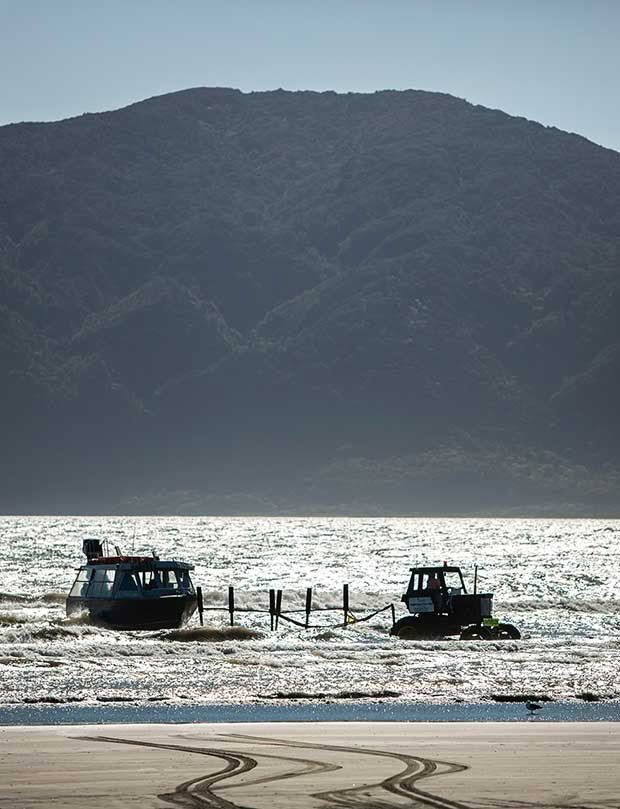
Island life means being very careful with consumption. Water must come from the sky, electricity must be generated, all provisions must be brought over and all rubbish taken off. Kāpiti Island Nature Tours runs on solar energy, with solar panels on the lodge, cabins and even the glamping tents banking power to use at night, although a diesel generator can be fired up in the winter and on less sunny days. Manaaki says power usage is constantly tracked.
Toilets are a mix of composting and septic tanks. “They must be emptied by a helicopter flying over a tank that our tanks are emptied into, and then flown back to the mainland. Rinse and repeat until it’s all done. And yes, that’s every bit as expensive as it sounds. But life on an island is expensive, because everything must be brought in and taken off, including all recycling and refuse,” says Manaaki. “Being as self-sufficient as possible is critical for us. We’re always improving our systems to enhance our sustainability.”
- Sue Barrett is a keen quilter and has sewn nearly all the bed covers as well as other home comforts, such as the hot-water-bottle covers.
SEEING SPOTTED KIWI
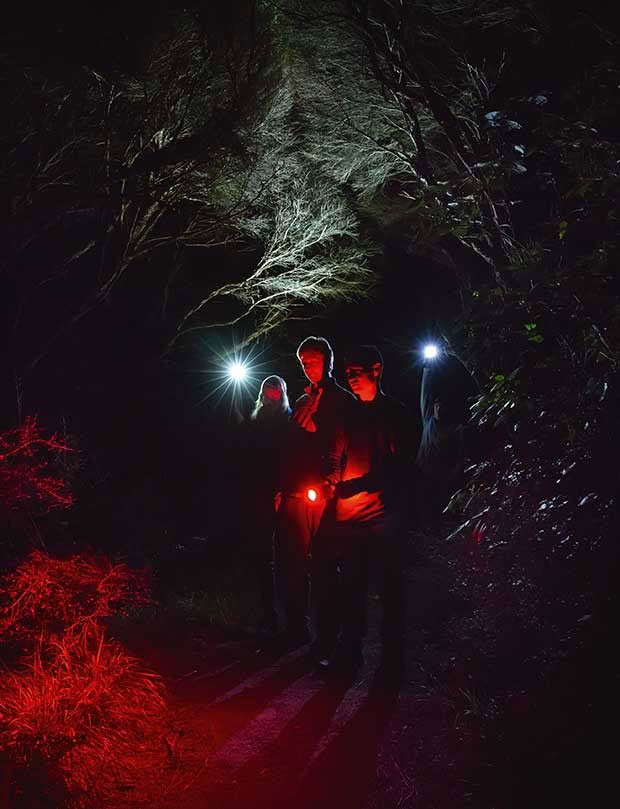
Eight people can walk quite quietly when required, and for kiwi-spotting it’s essential. Little spotted kiwi — or kiwi pukupuku — live in abundance (apparently) around the Kāpiti Island Nature Tours lodge, leaving their burrows to forage in the dark.
So a night-time kiwi-spotting stroll is also an essential part of a stay. Stepping splay-legged and heel-toe, we walk in single file in the near pitch black, our eyes trained to the guide’s bobbing red light (less alarming for kiwi). Our guide flicks her torch from side to side in the bush, hoping to see movement indicating passing kiwi.
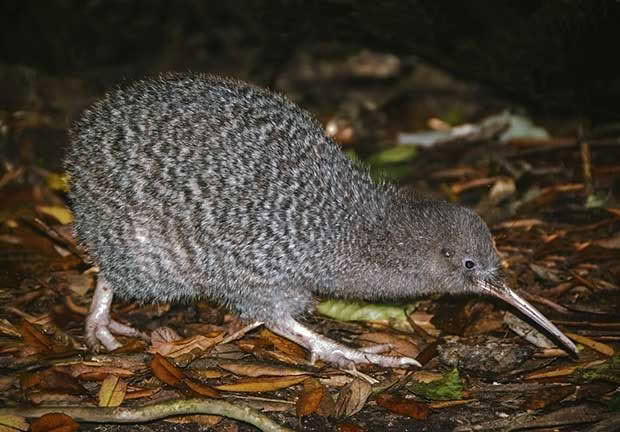
In theory, it should be easy as kiwi are lots of things, but quiet they are not. They call from the bush; the male’s chirrup pitching higher in intensity as he strains for a female’s reply. Nothing. “Wait, there’s a kiwi,” stage whispers one guest. “Oh, hang on, it’s a rock.” Weka are another common source of false positives. Our guide spots a kiwi and five minutes of hope are spent hovering around a bush.
But it’s seen us, heard us. It’s long gone. Not a kiwi, but we all delight in a little blue penguin that poses graciously for a few seconds before ambling back to the bush. “We’ve seen kiwi nearly every night,” says Manaaki. “Sometimes they walk right through the group, even brushing through our legs. If you get up during the night, take care because you’re quite likely to see them round your cabins.”
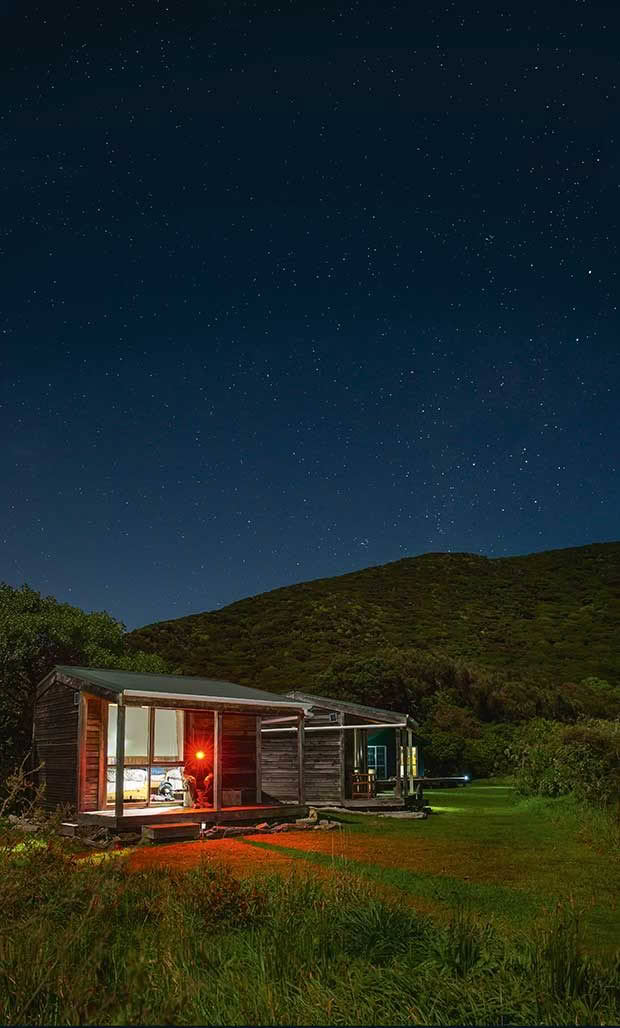
Later, in bed, ruru (moreporks) hoot, kākā screech like tantruming children refusing to sleep, penguins flap, weka call and wētā scrape their hind legs. In the dark of the bush, there might not always be much to see but there’s plenty to hear.
Up to 20 people can experience Kāpiti Island by night, with most sleeping in the cabins.
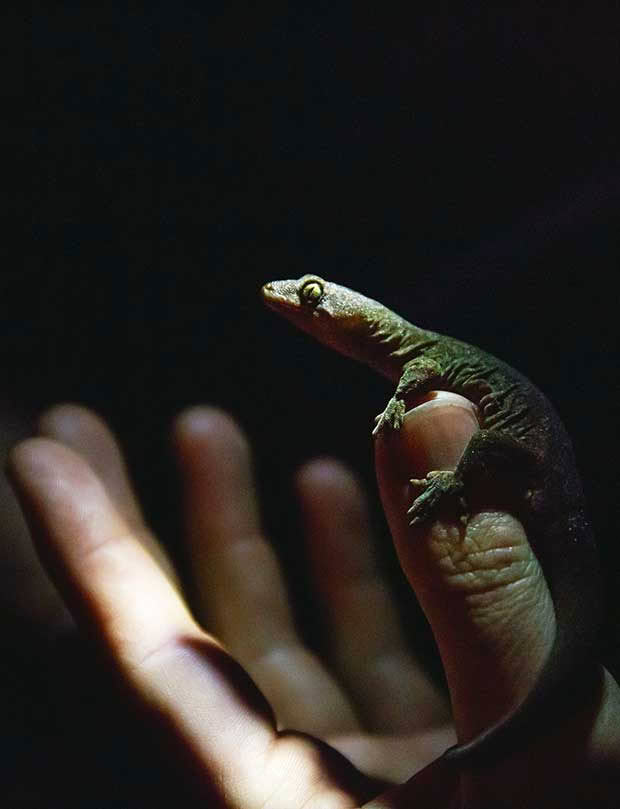
The island has to be one of the best places to gaze at the night sky, search for kiwi, and try to identify bird calls. But invertebrates and lizards have also thrived since pests were eradicated in 1996, including the common gecko which likes to hide in the seats of the visitors’ shelter.
THIS SUMMER, MANAAKI WILL BE…
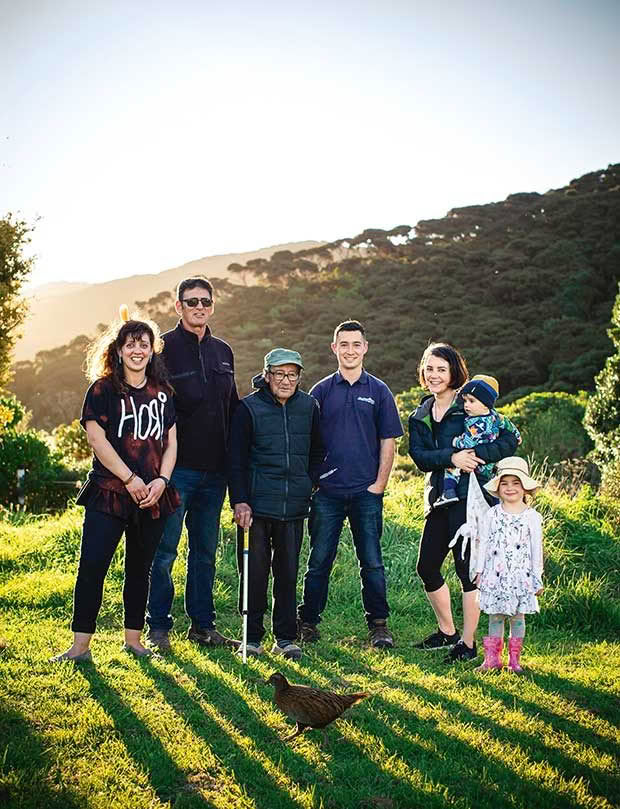
Kāpiti Island’s whānau future is safe with a new generation coming on. From left: Pania Barrett, Wayne Spratt, Boysie Barrett, Manaaki Barrett, Danielle Barrett, Kāhu o te Rangi Barrett (1) and Huhana Barrett (4).
Reading: As many Hairy Maclary books my one-year-old nephew can persuade me to.
Cooking: Freshly harvested paua and freshly caught fish.
Drinking: Margaritas made with good-quality Mexican tequila — I just received a bottle as a gift.
Listening to: Troy Kingi’s galactic 1970s funk album, Shake That Skinny Ass All the Way to Zygertron.
Carrying out family traditions such as: Spending Christmas Day with my 94-year-old granddad before heading over to Kāpiti Island on Boxing Day for a week of whānau time.
Love this story? Subscribe now!
 This article first appeared in NZ Life & Leisure Magazine.
This article first appeared in NZ Life & Leisure Magazine.
